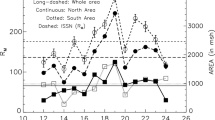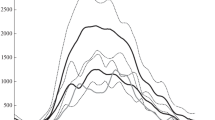Abstract
According to research results from solar-dynamo models, the northern and southern hemispheres may evolve separately throughout the solar cycle. The observed phase lag between the northern and southern hemispheres provides information regarding how strongly the hemispheres are coupled. Using hemispheric sunspot-area and sunspot-number data from Cycles 12 – 23, we determine how out of phase the separate hemispheres are during the rising, maximum, and declining period of each solar cycle. Hemispheric phase differences range from 0 – 11, 0 – 14, and 2 – 19 months for the rising, maximum, and declining periods, respectively. The phases appear randomly distributed between zero months (in phase) and half of the rise (or decline) time of the solar cycle. An analysis of the sunspot cycle double peak, or Gnevyshev gap, is conducted to determine if the double-peak is caused by the averaging of two hemispheres that are out of phase. We confirm previous findings that the Gnevyshev gap is a phenomenon that occurs in the separate hemispheres and is not due to a superposition of sunspot indices from hemispheres slightly out of phase. Cross hemispheric coupling could be strongest at solar minimum, when there are large quantities of magnetic flux at the Equator. We search for a correlation between the hemispheric phase difference near the end of the solar cycle and the length of solar-cycle minimum, but found none. Because magnetic flux diffusion across the Equator is a mechanism by which the hemispheres couple, we measured the magnetic flux crossing the Equator by examining Kitt Peak Vacuum Telescope and SOLIS magnetograms for Solar Cycles 21 – 23. We find, on average, a surplus of northern hemisphere magnetic flux crossing during the mid-declining phase of each solar cycle. However, we find no correlation between magnitude of magnetic flux crossing the Equator, length of solar minima, and phase lag between the hemispheres.
Similar content being viewed by others
References
Antonucci, E., Hoeksema, J.T., Scherrer, P.H.: 1990, Astrophys. J. 360, 296.
Babcock, H.W.: 1961, Astrophys. J. 133, 572.
Cameron, R., Schüssler, M.: 2007, Astrophys. J. 659, 801.
Charbonneau, P.: 2005, Solar Phys. 229, 345.
Charbonneau, P.: 2007, Adv. Space Res. 40, 899.
Chatterjee, P., Nandy, D., Choudhuri, A.R.: 2004, Astron. Astrophys. 427, 1019.
Dikpati, M., Gilman, P.A.: 2001, Astrophys. J. 559, 428.
Durrant, C.J., Wilson, P.R.: 2002, Solar Phys. 214, 38.
Durrant, C.J., Turner, J.P.R., Wilson, P.R.: 2004, Solar Phys. 222, 345.
Feminella, F., Storini, M.: 1997, Astron. Astrophys. 322, 311.
Gnevyshev, M.N.: 1963, Sov. Astron. 7, 3.
Gnevyshev, M.N.: 1967, Solar Phys. 1, 107.
Harvey, K.L., White, O.R.: 1999, J. Geophys. Res. 104(A9), 19759.
Joshi, B., Joshi, A.: 2004, Solar Phys. 219, 343.
Kane, R.P.: 2005, Solar Phys. 229, 387.
Leighton, R.B.: 1964, Astrophys. J. 140, 1547.
Leighton, R.B.: 1969, Astrophys. J. 156, 1.
Li, K.J., Liu, X.H., Yun, H.S., Xiong, S.Y., Liang, H.F., Zhao, H.Z., Zhan, L.S., Gu, X.M.: 2002, Publ. Astron. Soc. Pac. 54, 629.
Ossendrijver, A.J.H., Hoyng, P.: 1996, Astron. Astrophys. 313, 959.
Storini, M., Pase, S., Sýkora, J., Parisi, M.: 1997, Solar Phys. 172, 317.
Temmer, M., Veronig, A., Hanslmeier, A.: 2002, Astron. Astrophys. 390, 707.
Temmer, M., Rybák, J., Bendík, P., Veronig, A., Vogler, F., Otruba, W., Pötzi, W., Hanslmeier, A.: 2006, Astron. Astrophys. 447, 735.
Vanlommel, P., Cugnon, P., van der Linden, R.A.M., Berghmans, D., Clette, F.: 2004, Solar Phys. 224, 113.
Wang, Y.-M., Sheeley, N.R. Jr.: 1991, Astrophys. J. 375, 761.
Author information
Authors and Affiliations
Corresponding author
Rights and permissions
About this article
Cite this article
Norton, A.A., Gallagher, J.C. Solar-Cycle Characteristics Examined in Separate Hemispheres: Phase, Gnevyshev Gap, and Length of Minimum. Sol Phys 261, 193–207 (2010). https://doi.org/10.1007/s11207-009-9479-6
Received:
Accepted:
Published:
Issue Date:
DOI: https://doi.org/10.1007/s11207-009-9479-6




